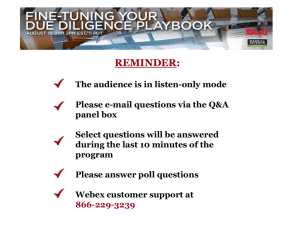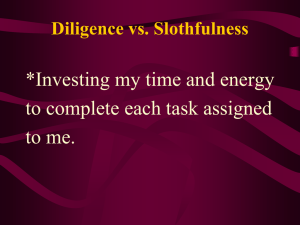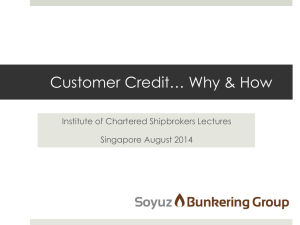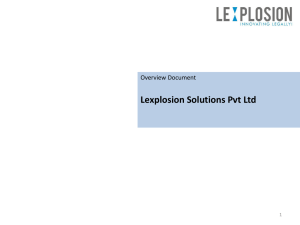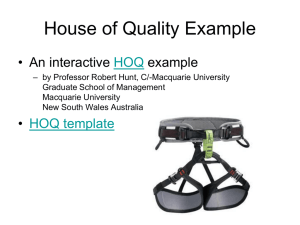Due Diligence - Angel Capital Summit
advertisement
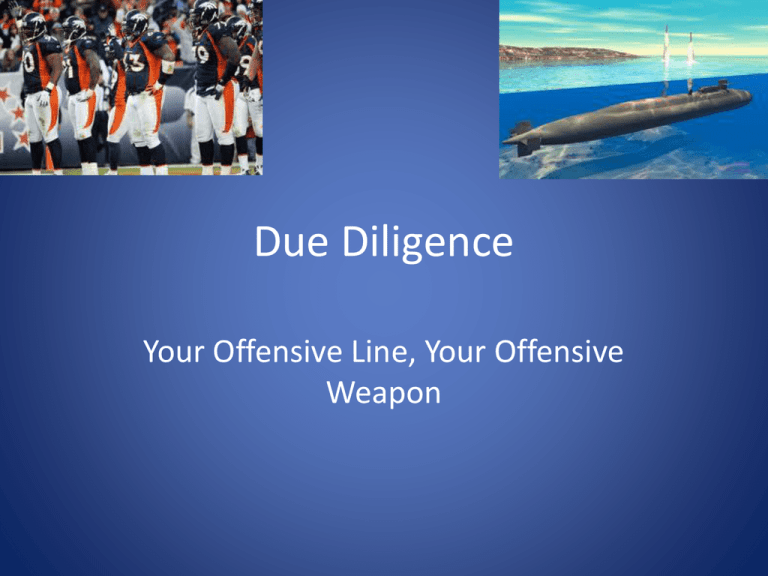
Due Diligence Your Offensive Line, Your Offensive Weapon Care and diligence bring luck. Thomas Fuller Why Due Diligence is Important Returns are positively correlated to hours spent on due diligence More than 40 hours = 7.1x returns Less than 20 hours = 1.1x returns What is the right amount of due diligence? • Due Diligence Sweet Spot ~ 40 hours – Not an exact science and depends on the deal • More doesn’t correlate to higher returns – Diminishing returns after initial threshold met • Need to be intentional and deliberate when you perform due diligence – in other words: Know what you are looking for and where to look for it. Due Diligence Process Phase I – High Level Sniff Test Phase II – Deep Due Diligence • Using Mullins Framework • Due Diligence Checklist The Seven Domains of Attractive Opportunities Market Domains Macro Level Industry Domains Market Attractiveness Industry Attractiveness Mission, Aspirations, Propensity for Risk Ability to Execute on CSFs Team Domains Micro Level Connectedness up and down Value Chain Target Segment Benefits and Attractiveness © 2006 John W. Mullins Sustainable Advantage Due Diligence Phase I Management Team Experience Target Market Clarity Produce/Service Description IP Potential Industry Definition Valuation Reasonableness, HighLevel Financial Summary, Exit Possibilities High-Level Risk Assessment Due Diligence Phase II Management Team Analysis Product/service comparison to direct and indirect competitive offerings IP research and investigation Details on the target market and breakdown on the company’s marketing plan Competitive matrix with positioning analysis Valuation comparisons and detailed financial analysis, exit scenarios and target ROI Detailed risk assessment Due Diligence Product/Service • Features versus benefits • What is the pain being solved? • How does the product/service’s benefits relieve that pain? • Current product/service alternatives? • IP potential? Micro-Market Analysis • What benefits does the offering provide that other solutions don’t? Micro-Market Analysis •What customer pain will the offering resolve? •How strong of an incentive do customers have to give you their money? –Evidence? •Will customers purchase at a price that works for the business model? Micro-Market Analysis • What evidence can you provide to show that your target market has the potential to grow? • Are there other segments that could benefit from a related offering? How do they benefit? • Can you develop capabilities that are transferable from one segment to another? Micro-Market Analysis • How attractive is the micro-market? – Fit market into one of three buckets: • Attractive • Fairly attractive • Not attractive Macro-Market Analysis How big is the market? • Secondary research • Number of potential customers How fast has the market grown historically? • One year growth? • Two year growth? • Five year growth? How fast will the market grow? • Next 6 months? • Next 2 years? • Next 5 years? What trends will affect the market? • Economic, demographic, sociocultural, technological, regulatory or natural. Macro-Market Analysis • How attractive is the Macro-Market? – Fit market into one of three buckets: • Attractive • Fairly attractive • Not attractive Industry Analysis Porter’s Five Forces Industry Analysis Blue Ocean or Bloody Ocean “Blue oceans….denote all the industries not in existence today – the unknown market space, untainted by competition. In blue oceans, demand is created rather than fought over. There is ample opportunity for growth that is both profitable and rapid.” Bloody Oceans – industry characteristics where companies fight and primarily compete on price. Industry Analysis • How attractive is the Industry? – Fit industry into one of three buckets: • Attractive • Fairly attractive • Not attractive Management Team Execution Risk • Does the management team have the relevant experience necessary to execute the business plan? – Industry Skills? – Technical Skills? – Transferable Skills? • Passion? Management Analysis • How attractive is the Management Team? – Fit into one of three buckets: • Attractive • Fairly attractive • Not attractive Financial Analysis • What is the company’s revenue Model • Are the revenue projections realistic? – Has the founders included the details on ‘how’ they plan on achieving these projections? • Gross, operational and net margins? • Sources and uses of funds? • Projections – Management, downside and upside scenarios? – ROI for investors? Financial Analysis • How attractive are the financial terms? – Fit into one of three buckets: • Attractive • Fairly attractive • Not attractive Risk Assessment • Industry Risk – Changes to Porter’s Five Forces • Market (Product/Service) Risk – Changes in customer preference • Financial Risk – Appropriateness of fund sources and uses • Execution Risk – Management team execution ability Due Diligence Checklist - Attachment Efficient Due Diligence • How can you work with others to share in due diligence tasks? – Angel groups/forums • Deal flow • Collaboration • Leverage investor specialties/experience – Lead investor strategy – Due diligence delegation based on specialties Q&A Ryan Goral www.separtners-llc.com Twitter: @ryangoral
